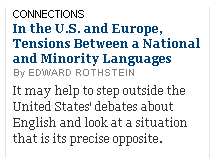May 29, 2006
Tensions between a singular and plural nouns
New York Times cultural critic Edward Rothstein has a provocative column about the Senate vote to declare English the "national language," contrasting the legislation with the European Charter for Regional and Minority Languages. Rothstein's pointed arguments about the divergent American and European approaches to multilingualism deserve serious consideration, but I had a hard time getting past the headline that the Times stuck on the column in the online edition, both in the main Arts section and on the page for the article itself.
It's another case of contracted "headlinese" leading to a curious, if not downright bizarre, grammatical construction.
We are of course expected to read
(1) tensions between [ [a national Ø] and [minority languages] ]
as elliptical for
(2) tensions between [ [a national language] and [minority languages] ]
rather than the ill-formed
(3) *tensions between [ [a national languages] and [minority languages] ].
Presumably the full version (2) was deemed too long for the space allotted for the headline (three short "decks" on the main Arts page and two longer ones on the article page). But the contracted version just doesn't work for me: I stumbled over the headline, expecting to find a singular head noun to agree with the singular article in "a national..." What we have here is yet another flavor of WTF coordination, this time with a singular-plural conflict between the two conjoined NPs.
It would have been so much simpler if the headline-writer had just omitted the singular article a, leaving
(4) tensions between [ [national Ø] and [minority languages] ]
which unproblematically expands to
(5) tensions between [ [national languages] and [minority languages] ].
So what's wrong with that? Well, it's a bit less precise given the context of the article, which considers policies balancing a country's national language (e.g., German) and its minority languages (e.g., Low German, Sater Frisian and Lower Sorbian). So the "tensions" are in a one-to-many relationship (between a single national language and multiple minority languages) rather than a many-to-many relationship. The problem is that there is no concise way to express that one-to-many correspondence without causing an eyebrow-raising mismatch between singular and plural conjuncts. In this case, I would prefer the semantic imprecision of (4) to the grammatical weirdness of (1).
The moral of the story: you can call English "national," but that doesn't make it rational.
[Update: The headline for the column in the print edition (as verified by the Nexis and ProQuest databases) is completely different: "Translated From Spanish (or Lower Sorbian or Breton), With High Emotion." That more creative style of headline-writing doesn't fly in online editions, as the New York Times itself explained in a recent article, "This Boring Headline Is Written for Google."]
Posted by Benjamin Zimmer at May 29, 2006 01:45 AM